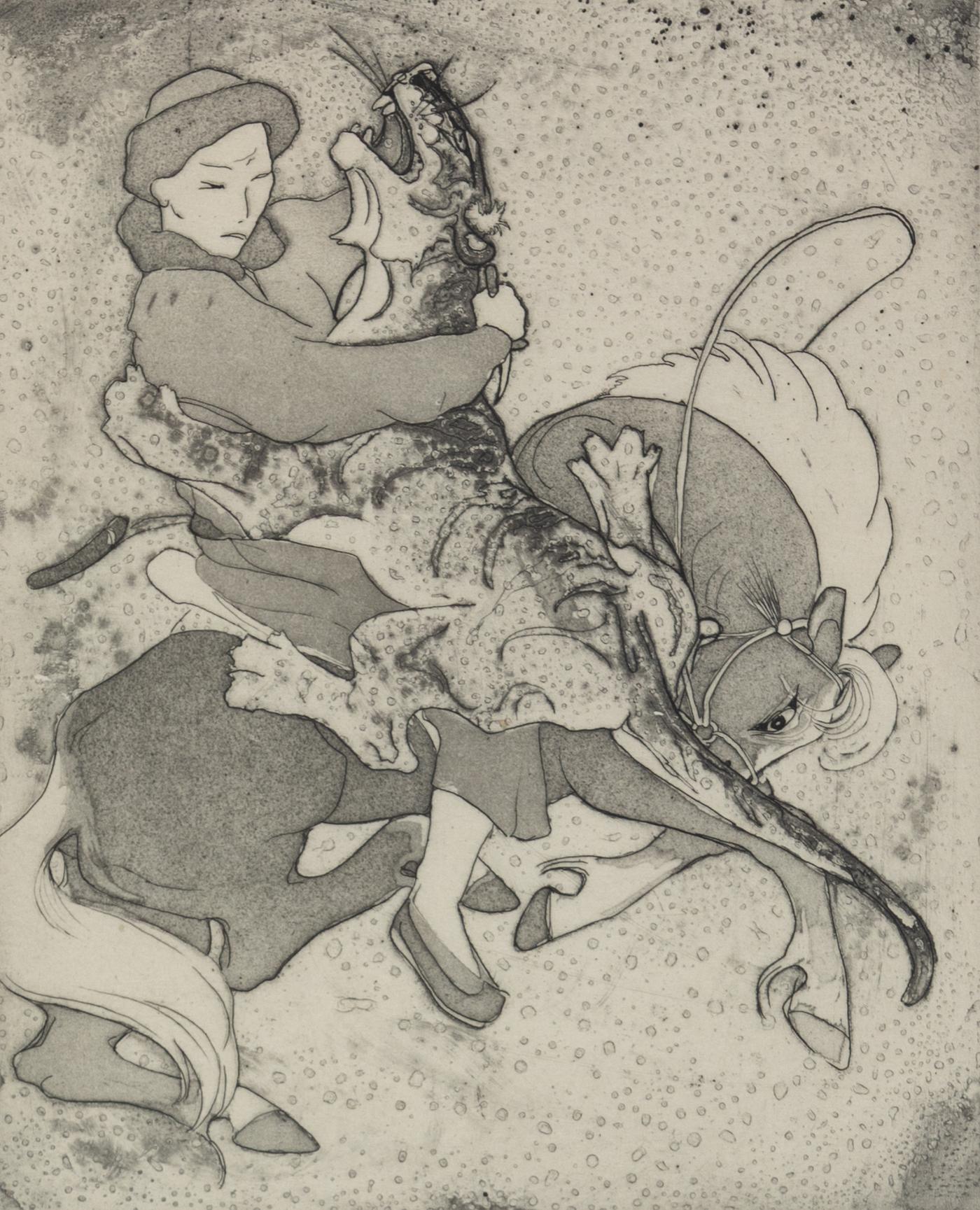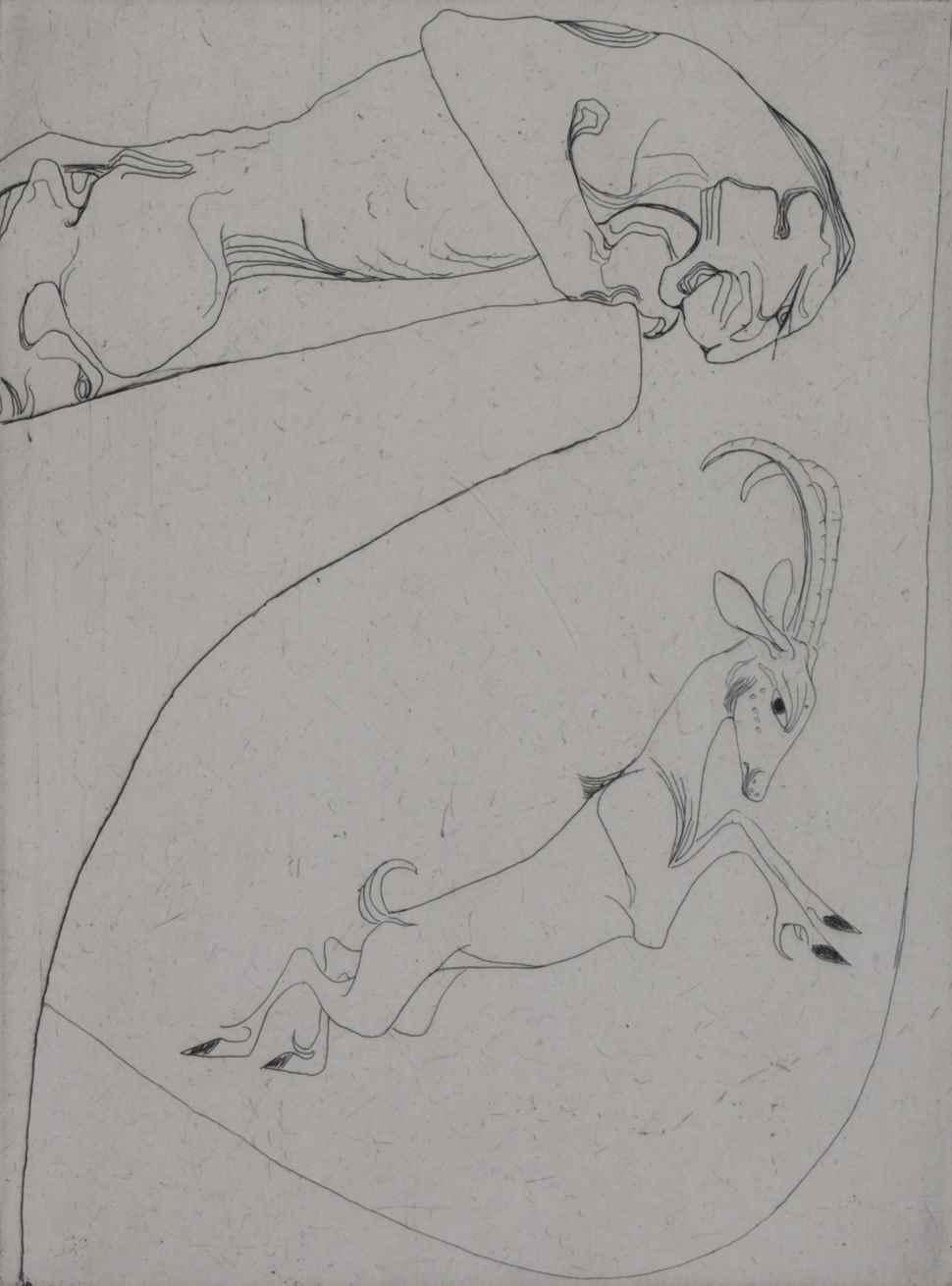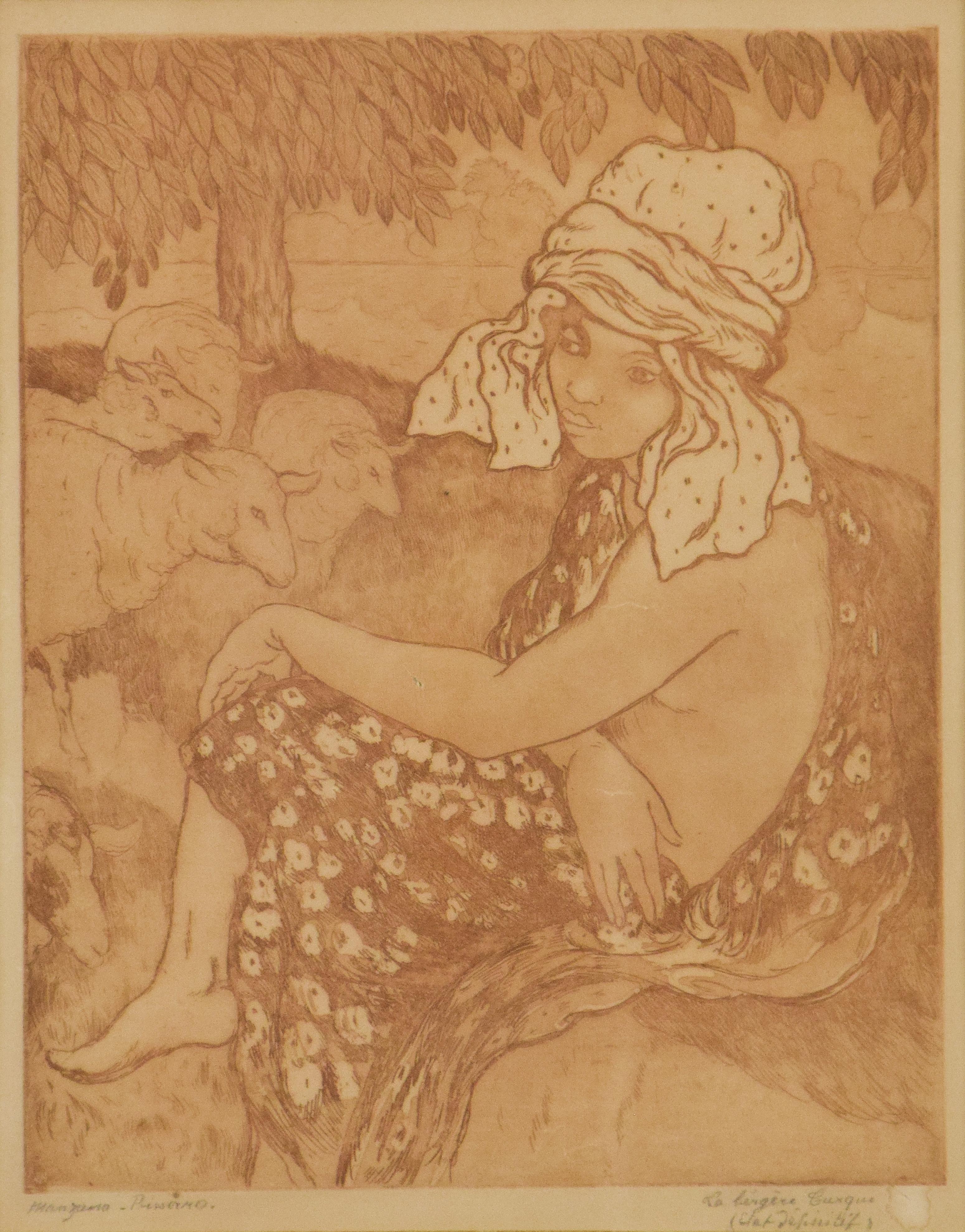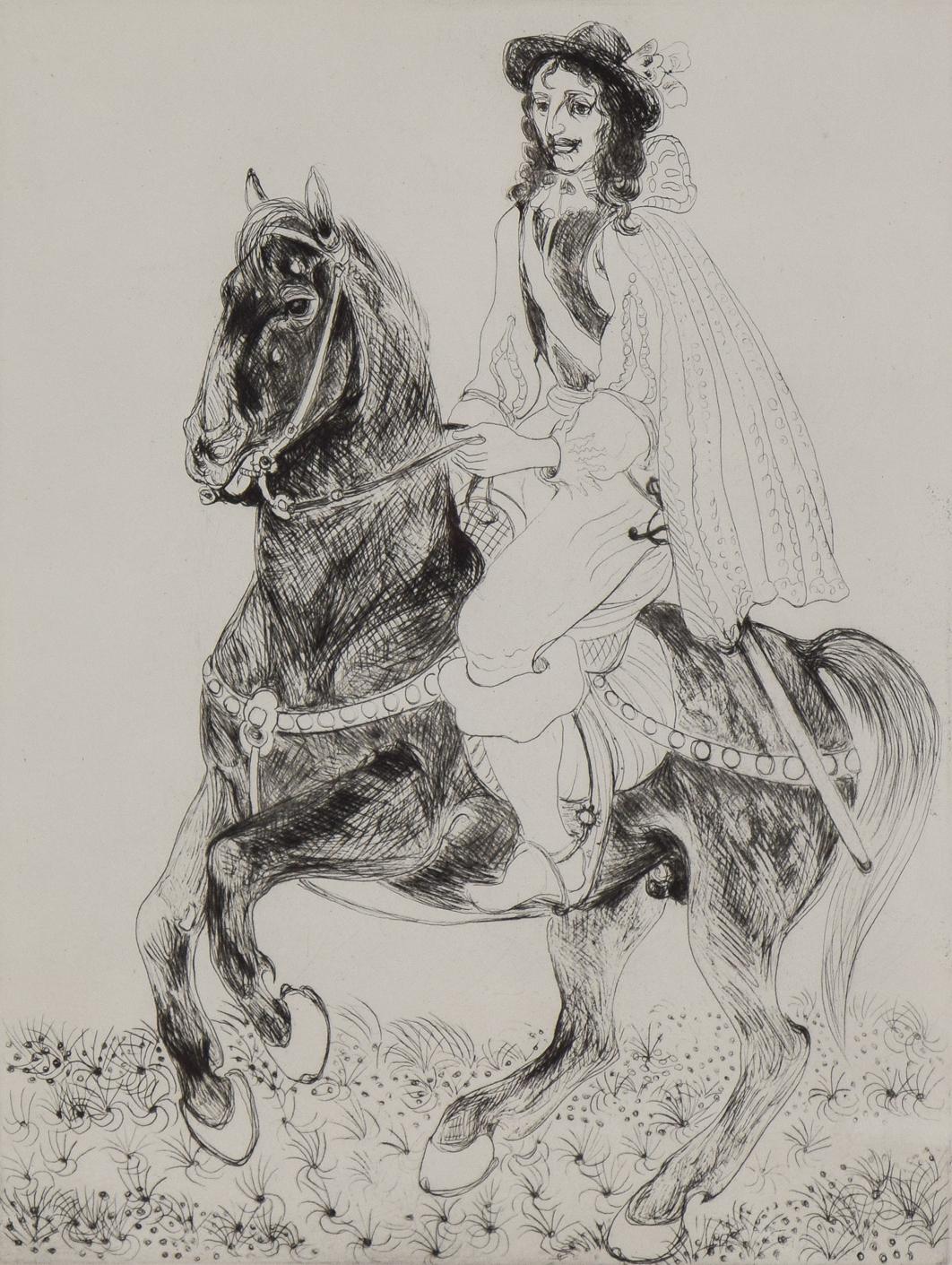Orovida PissarroThe Calf by Orovida Pissarro - Watercolour and etching1949
1949
About the Item
- Creator:Orovida Pissarro (1893 - 1968)
- Creation Year:1949
- Dimensions:Height: 6.89 in (17.5 cm)Width: 9.14 in (23.2 cm)
- Medium:
- Movement & Style:
- Period:
- Condition:
- Gallery Location:London, GB
- Reference Number:1stDibs: LU26129391732
Orovida Pissarro
Orovida Pissarro, the only child of Lucien and Esther Pissarro, was the first woman in the Pissarro family to become a professional artist and the first Pissarro of her generation to take up painting. Born in Epping, England, in 1893, she lived and worked predominantly in London, where she was a prominent member of several British arts clubs and societies.
Orovida first learned to paint in the Impressionist style from her father and, after a brief period of formal study with Walter Sickert in 1913, she renounced formal art schooling.
Throughout her career, Orovida always remained outside mainstream British art movements. Much to Lucien's disappointment, she soon turned away from naturalistic painting and developed an unusual style that combined elements of Japanese, Chinese, Persian and Indian art. Her rejection of Impressionism, which, for the Pissarro family, was a way of life, and her simultaneous decision to drop her famous last name and use simply Orovida as a nom de peintre, reflected a desire for independence and distance from the family legacy, of which she nevertheless remained proud.
Orovida's most distinctive works are her paintings from the 1920s and 1930s in gouache (she called her mixture body color) and tempera, applied in thin, delicate washes to silk, linen, paper or gold leaf and embellished with brocade borders. These elegant and richly decorative works generally depict non-Western subjects, for example: Mongolian horseback riders, African dancers and Persian princes, often engaged in activities such as dancing or hunting rituals.
The second half of Orovida's painting career is marked by a dramatic change in both style and subject matter. In the mid-1940s, she began to embrace contemporary subjects from everyday life and returned to a more naturalistic style. Her new style was more suited to oils, and thus, she returned to that medium.
Over the course of her life, Orovida was aware of the mixed blessing of having famous artists in the family; not only a grandfather and father but also four uncles, and towards the end of her life, she was instrumental in developing the Pissarro family archive that her mother had established at the Ashmolean Museum in Oxford.
(Biography provided by Stern Pissarro Gallery)
- ShippingRetrieving quote...Ships From: London, United Kingdom
- Return PolicyA return for this item may be initiated within 7 days of delivery.
- Man & Beast by Orovida Pissarro - EtchingBy Orovida PissarroLocated in London, GB*UK BUYERS WILL PAY AN ADDITIONAL 20% VAT ON TOP OF THE ABOVE PRICE Man & Beast by Orovida Pissarro (1893-1968) Etching 27 x 22 cm (10 ⁵/₈ x 8 ⁵/₈ inches) Signed and dated lower right, orovida 1924 Inscribed lower left, Final state no 12/40 and titled lower centre Artist biography: Orovida Camille Pissarro, Lucien and Esther Pissarro’s only child, was the first woman in the Pissarro family as well as the first of her generation to become an artist. Born in Epping, England in 1893, she lived and worked predominantly in London where she became a prominent member of several British arts clubs and societies. She first learned to paint in the Impressionist style of her father, but after a brief period of formal study with Walter Sickert in 1913 she renounced formal art schooling. Throughout her career, Orovida always remained outside of any mainstream British art movements. Much to Lucien's disappointment she soon turned away from naturalistic painting and developed her own unusual style combining elements of Japanese, Chinese, Persian and Indian art. Her rejection of Impressionism, which for the Pissarro family had become a way of life, together with the simultaneous decision to drop her famous last name and simply use Orovida as a ‘nom de peintre’, reflected a deep desire for independence and distance from the weight of the family legacy. Orovida's most distinctive and notable works were produced from the period of 1919 to 1939 using her own homemade egg tempera applied in thin, delicate washes to silk, linen or paper and sometimes embellished with brocade borders. These elegant and richly decorative works generally depict Eastern, Asian and African subjects, such as Mongolian horse...Category
1920s Post-Impressionist Animal Prints
MaterialsEtching
- Curves by Orovida Pissarro, 1919 - Etching PrintBy Orovida PissarroLocated in London, GBCurves by Orovida Pissarro (1893 - 1968) Etching, trial proof no. 54 20.2 x 15 cm (8 x 5 ⅞ inches) Signed and dated lower right, Orovida 1919 Inscribed lower left Trial proof no. 54 ...Category
1910s Post-Impressionist Animal Prints
MaterialsPaper, Etching
- Print by Georges Manzana Pissarro 'La Bergère Turque' (The Turkish Shepherdess)By Georges Henri Manzana PissarroLocated in London, GB'La Bergère Turque' (The Turkish Shepherdess) by Georges Manzana Pissarro (1871-1961) Etching 33.5 x 27 cm (13 ¼ x 10 ¾ inches) Signed lower left, Manzana Pissarro, titled and inscri...Category
1920s Post-Impressionist Animal Prints
MaterialsEtching
- Rupert Rides by Orovida Pissarro - Animal etchingBy Orovida PissarroLocated in London, GB*UK BUYERS WILL PAY AN ADDITIONAL 20% VAT ON TOP OF THE ABOVE PRICE Rupert Rides by Orovida Pissarro (1893-1968) Etching 31 x 23.5 cm (12 ¼ x 9 ¼ inches) Signed and dated lower righ...Category
1950s Post-Impressionist Animal Prints
MaterialsEtching
- Horse Pulling Hay Cart by Félix Pissarro - Animal etchingBy Félix PissarroLocated in London, GBHorse Pulling Hay Cart by Félix Pissarro (1874-1897) Etching 19.5 x 15 cm (7 ⅝ x 5 ⅞ inches) Exhibition London, Stern Pissarro Gallery, Camille Pissarro & hi...Category
1890s Post-Impressionist Animal Prints
MaterialsEtching
- Woman with Black Swans by Georges Manzana Pissarro - MonotypeBy Georges Henri Manzana PissarroLocated in London, GBWoman with Black Swans by Georges Manzana Pissarro (1871-1961) Monotype 26.4 x 19.5 cm (10 ³/₈ x 7 ⁵/₈ inches) Signed lower right, Manzana Executed circa 1908 Artist biography: Like...Category
Early 1900s Post-Impressionist Animal Prints
MaterialsMonotype
- Circus Girl with Horses Lithograph with Hand ColoringBy Marcel VertèsLocated in Surfside, FLThis is an original hand signed (I believe it is also hand colored but i am not positive) Artists Proof Lithograph of a Circus scene. This depicts a circus girl with horses. This ca...Category
1940s Post-Impressionist Animal Prints
MaterialsWatercolor, Lithograph
- L'AquariumBy (after) Georges BraqueLocated in New York, NYA very good impression of this color aquatint. Signed and numbered 2/100 in red crayon, lower margin. Published by Maeght, Paris.Category
1950s Fauvist Abstract Prints
MaterialsColor, Aquatint
- "A Dog's Dialogue with the Viewer" .Print on Canvas .size for orderLocated in Sempach, LUIn this oil painting, we observe a portrait of a dog gazing at the viewer. Its eyes are brimming with questions as if it's asking, "Are you leaving? Are you taking me with you? After...Category
21st Century and Contemporary Post-Impressionist Animal Prints
MaterialsCotton Canvas, Oil, Color
- Sandwich Tern (with Florida Cray Fish) (Florida Keys) /// Ornithology AudubonBy John James AudubonLocated in Saint Augustine, FLArtist: John James Audubon (American, 1785-1851) Title: "Sandwich Tern (with Florida Cray Fish) (Florida Keys)" (Plate CCLXXIX - 279; part No. 56) Portfo...Category
1830s Victorian Animal Prints
MaterialsGold Leaf
- Tropic Bird /// Ornithology John James Audubon Shorebird Ocean Beach SeascapeBy John James AudubonLocated in Saint Augustine, FLArtist: John James Audubon (American, 1785-1851) Title: "Tropic Bird" (Plate CCLXII - 262; part No. 53) Portfolio: The Birds of America, Havell Edition Year: 1835 Medium: Original Hand-Colored Engraving with Aquatint on double-elephant folio, J. Whatman paper Limited edition: approx. 180 Printer: Robert Havell Jr., London, England Publisher: John James Audubon, London, England Framing: Not framed, but matted in a handmade custom French matting Matted size: 30" x 38.75" Sheet size: 25.5" x 36" Platemark size: 20.75" x 30.25" Image size: 18.5" x 27.75" Condition: A few tiny foxmarks. In excellent condition with clean paper and strong colors Rare Notes: Provenance: private collection - New York, NY. Engraved, printed, and hand-colored by English artist Robert Havell Jr. (1793-1878). Comes from Audubon's monumental book volume "The Birds of America", (Havell Edition, 1827-1838), which consists of 435 hand-colored, life-size prints, made from engraved plates, with each sheet originally measuring around 39" x 26". "J. Whatman 1835" watermark upper right. Based on a composition painted between 1832 and 1835. Audubon sailed the entire length of Florida, around the Keys and as far as the Dry Tortugas, from which, on another occasion, "The specimens - in the plate were taken - by my kind friend Robert Day, Esq. of the United States Revenue Cutter...Category
Early 1800s Victorian Animal Prints
MaterialsIntaglio, Watercolor, Engraving, Aquatint
- Red Phalarope /// Ornithology John James Audubon Bird Animal Landscape HavellBy John James AudubonLocated in Saint Augustine, FLArtist: John James Audubon (American, 1785-1851) Title: "Red Phalarope" (Plate CCLV - 255; part No. 51) Portfolio: The Birds of America, Havell Edition Year: 1835 Medium: Original Hand-Colored Engraving with Aquatint on double-elephant folio, J. Whatman paper Limited edition: approx. 180 Printer: Robert Havell Jr., London, UK Publisher: John James Audubon, London, UK Sheet size: 22.25" x 29" Platemark size: 15.75" x 22.63" Image size: 13.25" x 20.75" Condition: One small tear upper left in margin which has been professionally repaired. In excellent condition with clean paper and strong colors Rare Notes: Comes from Audubon's monumental book volume "The Birds of America", (Havell Edition, 1827-1838), which consists of 435 hand-colored, life-size prints, made from engraved plates, with each sheet originally measuring around 39" x 26". Engraved, printed, and hand-colored by English artist Robert Havell Jr. (1793-1878). "J. Whatman 1834" watermark upper left. Based on a composition painted in London in 1835. Edward Dwight...Category
1830s Victorian Animal Prints
MaterialsWatercolor, Intaglio, Engraving, Aquatint






